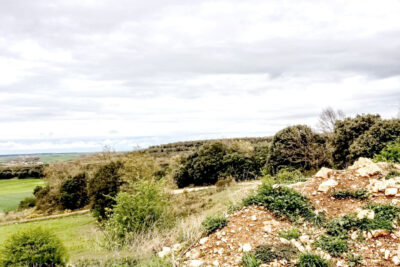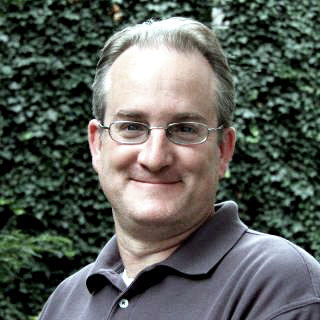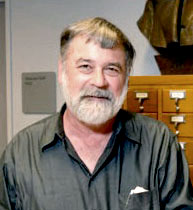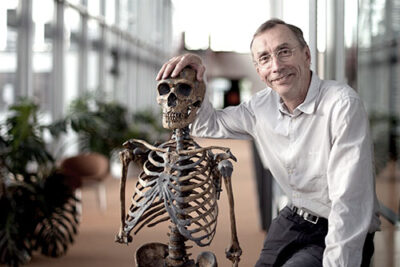 The genomic revolution is an increasingly challenging, long-standing orthodoxy in human evolution. An international team of geneticists headed by Matthias Meyer (pictured right below) of the Max Planck Institute for Evolutionary Anthropology in Germany reported in the journal Nature earlier this month.
The genomic revolution is an increasingly challenging, long-standing orthodoxy in human evolution. An international team of geneticists headed by Matthias Meyer (pictured right below) of the Max Planck Institute for Evolutionary Anthropology in Germany reported in the journal Nature earlier this month.
The team studied the mtDNA of 28 fossilized hominins estimated to be 400,000 years old from the Sima de Los Huesos cave in northern Spain‘s Sierra de Atapuerca Mountain range (pictured left).
Meyer’s team, which included legendary Swedish geneticist Svante Paabo, analyzed the genetics of these fossils collected during the 1970s. The study report, entitled “A mitochondrial genome sequence of a hominin from Sima de Los Huesos,” unexpectedly concluded that the fossils were genetically similar to the Denisovans, even though they morphologically resembled Neanderthals. Sima de los Huesos means “Pit of the Bones.”
Ancestry Models
Denisovans are of East Asian ancestry. Since the genetic evidence supports an out-of-Asia model while the morphological evidence supports an out-of-Africa model, human evolution orthodoxy faces a dilemma. In an interview with TIME science writer Per Liljas, Meyer explains –
“The fact that they show a mitochondrial genome sequence similar to that of Denisovans is irritating. Our results suggest that the evolutionary history of Neanderthals and Denisovans may be very complicated.”
Charles Darwin supported the out-of-Africa model of human evolution “by means of natural selection.” As anthropologist Richard Kline of Stanford University, in a 2009 editorial entitled “Darwin and the recent African origin of modern humans” published in PNAS, explains –
“The fossil record now confirms that Darwin and [Thomas] Huxley were right to place human origins in Africa.”
In 1856, the first Neanderthal fossil was unearthed in a German limestone quarry. Darwin considered the fossil of African ancestry in The Descent of Man –
“It is therefore probable that Africa was formerly inhabited by extinct apes closely allied to the gorilla and chimpanzee; and as these two species are now man’s nearest allies, it is somewhat more probable that our early progenitors lived on the African continent than elsewhere.”
Darwin’s support of the out-of-Africa model, however, landed Darwin at odds with the more popular nineteenth-century out-of-Asia (Denisovan) model popularized by German embryologist Ernst Haeckel and British geologist William Dawkins.
By the mid-twentieth century, Darwin’s out-of-Africa model had gained widespread popularity, emerging as the orthodoxy of human evolution. The genomic revolution, however, is no respecter of subjective beliefs.
Model Critics
Science writer Jennifer Welsh, in the article “400,000-Year-Old Hominin DNA Throws Everything We Know About Human Evolution Into Disarray,” explains –
“Finding their DNA thousands of miles and hundreds of thousands of years away from where we thought Denisovans evolved throws everything we know about ancient humans and how they spread out around the globe and evolved into distinct species into question.”
Meyer agrees –
“It’s extremely hard to make sense of. We still are a bit lost here.”
In the National Geographic article “DNA From Ancient Site in Spain Reshapes Human Family Tree,” science manager Miguel Vilar (pictured left) looked for a new plan –
“Now, the story has changed, and we are scrambling to come up with a new narrative.”
A human fossil in Spain with East Asian genetics was a surprise. In an interview with science writer Liz Fuller-Wright, in the article “Why scientists are baffled by a half-million-year-old human thigh bone,” subtitled “Scientists sequenced 400,000-year-old mitochondrial DNA, exploding the previous record for oldest DNA and introducing new questions into European and Asian history,” Meyer explains –
“The fact that the mtDNA [mitochondrial DNA] of the Sima de Los Huesos hominin shares a common ancestor with Denisovan rather than Neanderthal mtDNAs is unexpected since its skeletal remains carry Neanderthal-derived features.”
“This really raises more questions than it answers, really,” said senior author Svante Paabo, a biologist at the Max Planck Institute for Evolutionary Anthropology in Germany, in an interview with Monte Morin of the Los Angeles Times. “It’s a big surprise.”
Joseph Stromberg (pictured right), writing for the Smithsonian Magazine, in the article entitled “Scientists Just Sequenced the DNA From A 400,000-Year-Old Early Human,” after reviewing available evidence, conceded –
“If this sounds like a complicated family tree to you, you’re not alone. This analysis, along with earlier work, adds further mystery to an already puzzling situation. Initial testing on the Denisovan finger bone found in Siberia, for instance, found that it shared mtDNA with modern humans living in New Guinea, but nowhere else. Meanwhile, it was previously thought that Neanderthals had settled in Europe and Denisovans further east, on the other side of the Ural Mountains. The new analysis complicates that idea.”
Niles Eldredge (pictured left),  Curator, along with Ian Tattersall, curator emeritus, both of the American Museum of Natural History, as early as 1982, recognized the problem with the once-popular human evolution orthodoxy, noting –
Curator, along with Ian Tattersall, curator emeritus, both of the American Museum of Natural History, as early as 1982, recognized the problem with the once-popular human evolution orthodoxy, noting –
“One could confidently expect that as more hominid fossils were found, the story of human evolution would become clearer. Whereas, if anything, the opposite has occurred.”
Henry Gee, chief science writer for the journal Nature, regretting the increasing subjectivity of driving the science establishment in support of a theory, notes –
“To take a line of fossils and claim that they represent a lineage is not a scientific hypothesis that can be tested, but an assertion that carries the same validity as a bedtime story—amusing, perhaps even instructive, but not scientific.”
Darwin’s dilemma intensifies.
Genesis
Fossils offer the only direct evidence of natural history. Evidence from the fossil record, however, as well as the new genetic evidence from the northern Spanish cave, undermines the long-standing but now outdated.  Human evolution orthodoxy. Paleontology, since the publication of The Origin of Species, has conveyed a long, hostile history against the theory of human evolution.
Human evolution orthodoxy. Paleontology, since the publication of The Origin of Species, has conveyed a long, hostile history against the theory of human evolution.
While increasingly challenging the theory of evolution, by contrast, the fossil record is compatible with the Genesis account written by Moses. In the words of Isaac Newton (pictured right), an English mathematician, astronomer, and physicist is the world’s most influential scientist during the Scientific Revolution –
“There is one God, the Father, ever-living, omnipresent, omniscient, almighty, the Maker of heaven and earth, the one Mediator between God and man, the man Christ Jesus.”
Evidence of common ancestry and transitional links underscores why the theory of evolution remains speculative but not scientifically valid.
Human Evolution Orthodoxy is a Fossil Record article.
Darwin Then and Now is an educational resource on the intersection of evolution and science, highlighting the ongoing challenges to the theory of evolution.
Move On
Explore how to understand twenty-first-century concepts of evolution further using the following links –
-
- The Understanding Evolution category showcases how varying historical study approaches to evolution have led to varying conclusions. Subcategories include –
- Studying Evolution explains how key evolution terms and concepts have changed since the 1958 publication of The Origin of Species.
- What is Science explains Charles Darwin’s approach to science and how modern science approaches can be applied for different investigative purposes.
- Evolution and Science feature study articles on how scientific evidence influences the current understanding of evolution.
- Theory and Consensus feature articles on the historical timelines of the theory and Natural Selection.
- The Biography of Charles Darwin category showcases relevant aspects of his life.
- The Glossary defines terms used in studying the theory of biological evolution.
- The Understanding Evolution category showcases how varying historical study approaches to evolution have led to varying conclusions. Subcategories include –
2020 Update
2016 Study Update
Meyer and the team re-analyzed the Sima de Los Huesos fossils. They published their findings in the journal Nature entitled “Nuclear DNA sequences from the Middle Pleistocene Sima de los Huesos hominins.”
In this recent study, the team analyzed nuclear DNA (nDNA) in conjunction with mitochondrial DNA (mtDNA), as previously reported. Since the DNA repair mechanisms following mutation in mtDNA are less efficient than in nDNA, mtDNA is theoretically more useful in studying evolutionary relationships – phylogeny.
Based on nDNA, they reported –
“Here we recover nuclear DNA sequences from two specimens, which show that the Sima de los Huesos hominins were related to Neanderthals rather than to Denisovans, indicating that the population divergence between Neanderthals and Denisovans predates 430,000 years ago. A mitochondrial DNA recovered from one of the specimens shares the previously described relationship to Denisovan mitochondrial DNAs.”
WIKIPEDIA, 2020
Archaeological site of Atapuerca (Atapuerca includes the Sima de los Huesos site)
Since 2016, no other DNA studies, mtDNA or nDNA, have been performed.
Evolution 101, 2020
The site does not include information on Sima de Los Huesos
Smithsonian, 2020
On the website on the page entitled “What’s Hot in Human Origins,” the fossils of Sima de Los Huesos located in the Alapuera Mountains are discussed –
“At the bottom of a natural cave shaft, 43 feet deep, the Pit of Bones preserves some 28 individuals of Homo heidelbergensis…. The Pit of Bones remains a hot issue in human origins.”



